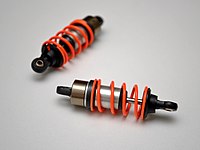
Photo from wikipedia
This work presents a novel design model of a magnetorheological (MR) fluid-based shock absorber (MR shock absorber in short) that can be applied to an aircraft landing gear system. When… Click to show full abstract
This work presents a novel design model of a magnetorheological (MR) fluid-based shock absorber (MR shock absorber in short) that can be applied to an aircraft landing gear system. When an external force acts on an MR shock absorber, pressure loss occurs at the flow path while resisting the fluid flow. During the flow motion, two pressure losses occur: the major loss, which is proportional to the flow rate, and the minor loss, which is proportional to the square of the flow rate. In general, when an MR shock absorber is designed for low stroke velocity systems such as an automotive suspension system, the consideration of the major loss only for the design model is well satisfied by experimental results. However, when an MR shock absorber is applied to dynamic systems that require high stroke velocity, such as aircraft landing gear systems, the minor loss effect becomes significant to the pressure drop. In this work, a new design model for an MR shock absorber, considering both the major and minor pressure losses, is proposed. After formulating a mathematical design model, a prototype of an MR shock absorber is manufactured based on the design parameters of a lightweight aircraft landing gear system. After establishing a drop test for the MR shock absorber, the results of the pressure drop versus stroke/stroke velocity are investigated at different impact energies. It is shown from comparative evaluation that the proposed design model agrees with the experiment much better than the model that considers only the major pressure loss.
Journal Title: Applied Sciences
Year Published: 2021
Link to full text (if available)
Share on Social Media: Sign Up to like & get
recommendations!